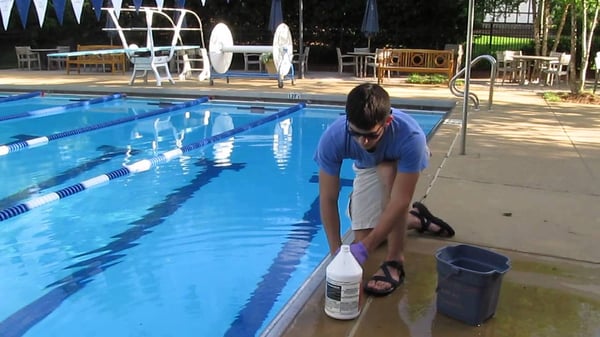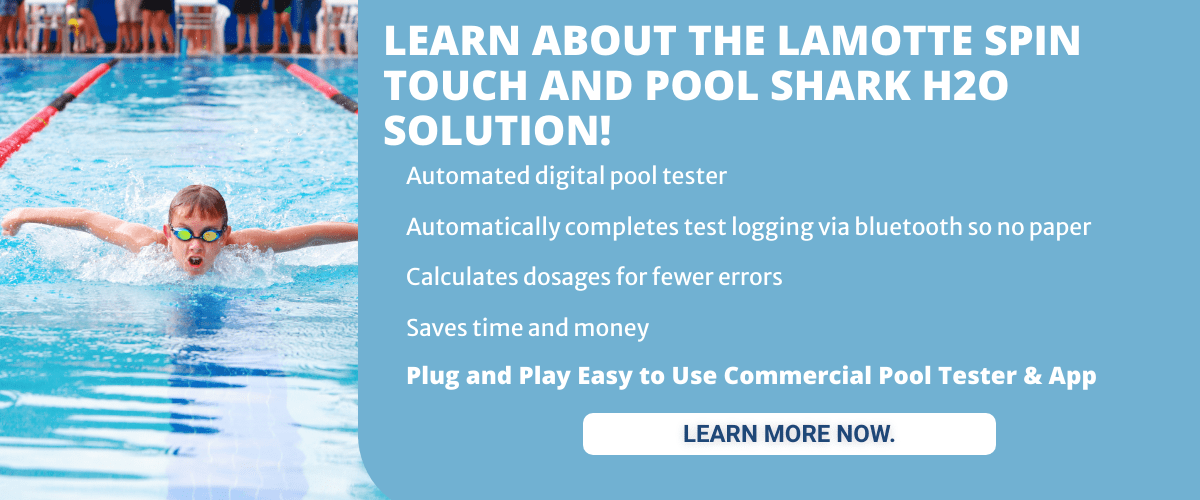We have a lot to worry about as pool operators when it comes to caring for the pool. We need to net out debris. We need to brush regularly. We need to vacuum as needed. The most important part is the water chemistry. Having balanced water not only protects the bathers and the pool’s surface, but it also protects your pool equipment. For clear, safe water, keep your water balanced at all times. This involves testing and adding the necessary chemicals like muriatic acid.

Pool Chemistry and Testing for Muriatic Acid
I cannot stress enough the importance of frequent water testing. It not only helps you stay on top of your water chemistry, but is required by your local health authority. Some regions even require testing every hour! We also need to log our results and keep records of our water tests. There are several ways to test your pool water for critical chemicals like muriatic acid.
While test strips are not allowed on commercial bodies of water, you have several good options. There are tablet test kits. There are reagent test kits. And my personal favorite, a spin touch. Pool Shark H2O is a modern technology app that helps you in so many ways. When paired with the LaMotte Spin Touch you simply fill a syringe with pool water and inject it into a spin disc. The spin disc is then placed in the spin lab and viola! In just 60 seconds, accurate results are sent to any device you have the Pool Shark H2O App installed on.
Once you have the results, the Pool Shark H2O App uses the Langelier Saturation Index to give you proper dosing instructions. This results in less chemical waste and saves you time–both of which saves you money.
Not ready to use the spin touch? That's okay. You can manually enter your test results into the Pool Shark H2O App and still get crucial dosing instructions. It also keeps digital logs of your water tests. No need for old-fashioned paper logs which can go unused, get misplaced, or get wet. They also take up a lot of space to store. Why not go digital?
Two of the fields you will need to adjust regularly are the swimming pool’s pH and alkalinity. If these fields come up high, you will need to bring the levels down using either muriatic acid or dry acid (sodium bisulfate).
Swimming Pool Muriatic Acid
Muriatic acid is a solution of diluted hydrochloric acid. Since it loses its potency the longer it sits, buy it at a swimming pool supply store versus a home improvement store. Pool stores tend to carry a higher percentage and get regular deliveries so it is more likely to be a better quality.
Muriatic acid can be used in swimming pools for a variety of tasks–not just lowering pH and alkalinity. You can use it to remove “efflorescence”. This I learned is just a fancy word for removing deposits of salt from rock or stucco. It is also a great stain remover for things such as rust. Always wear your PPE (Personal Protective Equipment) when handling muriatic acid. Proper storage is also important. Allow for sufficient separation from other chemicals such as liquid chlorine. Remember, never mix chemicals together!
Muriatic acid is also used in an acid wash, which is done when the pool is completely empty. It can remove pesky stains and brighten plaster. It is also used to clean salt cells. You may find yourself needing to remove calcium build up from a cartridge or grids. Muriatic acid mixed with water can help with this task. It can also clean the grout between your swimming pool tiles. What a versatile product, huh?
Dry Acid for Swimming Pools
Dry acid is sodium bisulphate and is preferable to some pool operators. It is safe in any vessel and has a longer shelf life than muriatic acid. It is also safer to use since it comes in a granular form. It can cost a bit more, especially if you operate a large swimming pool. It also cannot be used as a stain remover like muriatic acid can.
Swimming Pool pH and Alkalinity
Why do we care about these fields? High levels can cause your water to become scale-forming. This can leave deposits of calcium on the waterline, inside your plumbing, and your equipment. We typically want our pH between 7.2-7.8. Alkalinity ideally should be between 80-120. Using the LSI (Langelier Saturation Index) can be extremely helpful in exactly how you should adjust. That is where the Pool Shark H2O App can really help. Unless you want to bust your worksheets from your CPO training, HA HA.
So now we know the features and benefits of both dry and liquid acid. Use your Pool Shark H2O App to help you dose it and your job will get that much easier. See you poolside!
More Commercial Pool Chemistry Resources
Free, vs Combined vs Total Chlorine - A Guide for Commercial or Public Pool Operators
Chlorine Shock vs Non-Chlorine Swimming Pool Shock
Why Being Able to Calculate the Volume of a Commercial or Public Swimming Pool is Important
Cyanuric Acid Levels in Swimming Pools
Ideal Alkalinity in Commercial Pools
Managing pH and Alkalinity in Pools
Commercial Pool Chlorine Management
Cyanuric Acid in Your Pool Too High? How to Remove Cyanuric Acid (Lower Pool Stabilizer)
Lowering Alkalinity in Swimming Pools
Reasons Your Public or Commercial Pool Water Could Be Cloudy
How to Lower pH in Pools, Water Parks and Water Features
Does Chlorine Kill Poop in a Swimming Pool?
Total Dissolved Solids: When Should I Drain My Pool?
Why Pool Chemical Storage Cabinets are Important for Commercial Pools
Storing Pool Chemicals: What Commercial Pool Operators Need to Know



